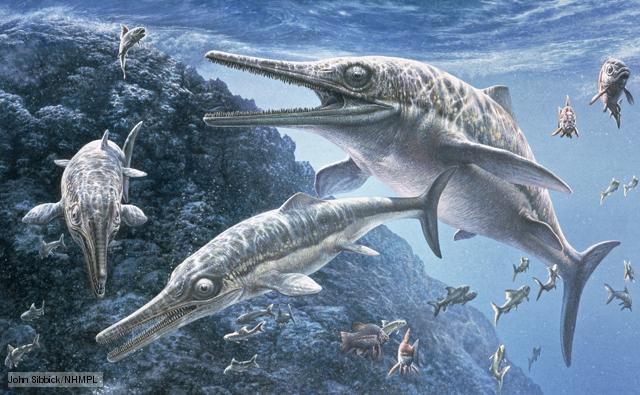Anatomy of Mesozoic Marine Reptiles
Looking at 3 major groups of animals and some of the specific anatomical advantage s they possessed to exploit their habitat particularly regarding locomotion and feeding.
The Sauropterygia -‘winged lizard’ are a group of reptiles and among their groups include the plesiosaurs and the pliosaurs.
Fig. 1 -Artists impression of a Pliosaur- Liopleurodon- attacking a plesiosaur
image courtesy of science photo library
Either long or short necked reptiles of varying size from 60cm up to 18m. Plesiosaurs being usually long necked where prey might be grasped as it swam past in a shoal of fish, whereas the shorter necked and much larger headed pliosaurs were a, larger, swifter, more aggressive creature and fed on larger prey most likely other plesiosaurs. The large head allowed it to develop bone crushing jaw muscles and combined with its long thick teeth it was a formidable predator. (Massar, 1988)
The fore limbs resembled great paddles that, it is believed, flapped similar to a modern birds wing where the motion in a figure of eight rotation generates lift and thrust. By evolving a circular girdle, the huge pressures upon the flippers required for this type of manoeuvrability were equally distributed throughout the structure . (Fig 2)
Fig. 2 pectoral girdle development of the Sauropterygia.
Image courtesy of palaeos.com
The Ichthyosaurs – fish reptile- were one of the earliest Mesozoic marine reptiles.
Fig. 3 Artist impression of an Ichthyosaur group.
image courtesy of BBC Nature
Varying in size and form, all possess a long rostrum usually packed with teeth, four fin like limbs, a fish like body and unmistakable large eyes. It is these, almost out of proportion, eyes that set the Ichthyosaurs apart from any other animal of the deep, presumably necessary for these creatures to be constantly alert for predators and prey. The more streamlined the body of the ichthyosaur -the larger the eye, and this has led to the conclusion that some of them were deep foragers (Perkins 2002).The limbs over evolutionary time have become more and more fin like but unlike the pliosaurs and plesiosaurs, these were not used for propulsion but for control similar to sharks and fish. Torpedo shaped bodies coupled with a spongy flexible bone structure, indicates that they were by and large fast and long ranging swimmers (De Buffrenil and Mazin, 1990) and may well have been endotherms (heat genearators). The vertebrae of the Ichthyosaurs are also very tightly packed only loosening up toward the tail indicating that they were powerful swimmers like modern day tuna.
The Mosasaurs-Meuse lizard, were probably the most lizard like of all the marine reptiles.
Fig. 5 Artist impression of a pair of Mossasaurs.
image courtesy of Nobu Tamura, Wikipedia
The body is usually slimmer and proportionally longer indicating that these creatures were not as fast or nimble as the Ichthyosaurs or Sauropterygia and swam with an undulating motion similar to eels of today. The limbs,generally fleshed webbing between elongated digits, performed like paddles and were used for locomotion along with the tail which was fleshed towards the posterior. (Masar,1988). Mosasaurs were squamates (snakes and lizards) possessing an intermandibular joint which, like snakes today, allowed the lower jaw to dislocate from the cranium enabling consumption of large prey (Lee et al. 1999). New fossil evidence coming to light shows some that later mosasaurs stiffened the anterior portion of the body and the as those of ichthyosaurs or the girdle became larger and stronger and the limbs became like those of the pliosaurs, enabling sub-aqueous flight. (Lindgren, 2011).
References:
Bardet, N., Jalil, N-E., De Lapparent de Broin, F., Germain, D.,Lambert, O., Amaghzaz, M. 2013. A Giant Chelonioid Turtle from the Late Cretaceous of Morocco with a Suction Feeding Apparatus Unique among Tetrapods. Open access.
Carpenter, K., Sanders, F., Reed, B., Reed, J. and Larson, P. 2010. Plesiosaur swimming as interpreted from skeletal analysis and experimental results. Transactions of the Kansas Academy of Science 113: 1/2, 1-34.
De Buffrenil, V. and Mazin, J-M. 1990. Bone Histology of the Ichthyosaurs: Comparative Data and Functional Interpretation: Paleobiology 16: 4, 435-447.
Lee, M. S. Y., Bell, G. L. Jr. and Caldwell, M. W. 1999. The origin of snake feeding, Nature 400: 655-659
Lindgren, J., Everhart, M.J., Caldwell, M. W. 2011.Three-Dimensionally Preserved Integument Reveals Hydrodynamic Adaptations in the Extinct Marine Lizard Ectenosaurus (Reptilia, Mosasauridae). Plos one :6 ,11
Massare, J.A. 1988.Swimming capabilities of Mesozoic marine reptiles: implications for method of predation Paleobiology, 14:2, 187-205.
Perkins, S. 2002. Sea Dragons. Science News, 162: 8, 122-124.
Sander, P.M., Chen, X., Cheng, L., Wang, X. 2011. Short-Snouted Toothless Ichthyosaur from China Suggests Late Triassic Diversification of Suction Feeding Ichthyosaur. Open access.



